Can robots create works of art? Can young engineers at
Johns Hopkins build machines that put something at least
resembling art on plain white paper?
The answer to the first question is still open to
debate. But students enrolled in a course called Sensors
and Actuators proved last week that they could indeed
accomplish the latter task — and have a lot of fun in
the process.
During an event dubbed ArtBot '04, held at the
Homewood campus, 26 teams of students showcased their
motley creations: mechanical devices designed to put paint,
ink and charcoal on paper in an appealing,
thought-provoking or, at least, interesting way. In
constructing the artbots, the students were required to use
the types of sensors and actuators they learned about in
previous course laboratory assignments. The products of
these art robots, judged by a panel of critics and sold to
the public for $1 apiece, ranged from surprisingly elegant
to, well, messy.
Nevertheless, organizers of the event hailed it as an
excellent opportunity for students to combine their lessons
in electronics and mechanics with the visual arts — a
field that's rarely represented in engineering courses.
Some of the machines applied colored lines to paper in
spiral or random patterns. One device, reminiscent of a
pinball machine, sent metal balls rolling through red
paint, which the spheres then smeared across white paper in
wild streaks. Another used sensors to detect the shape of a
patron's hand, which the machine then reproduced in
charcoal.
In some instances, the robots themselves may have
qualified as works of art. One team decorated its robot
with a Japanese ceramic "lucky cat." Another mounted paper
atop an old-fashioned vinyl phonograph record that revolved
beneath a colored marker. When patrons yelled into an
attached telephone handset, the sound waves caused the
marker to jiggle, altering the graphic design.
In yet another machine — one that was singled
out for its humor by the judges, who gave it an honorable
mention — a robotic dog moved toward a tiny fire
hydrant and deposited a blob of yellow paint beside it.
Team member Phil Nigon said, "We feel ours is more
'performance art.' "
The devices were graded by the course instructor,
Allison Okamura, an assistant professor of
mechanical
engineering in the Whiting School. The event, held at
the Mattin Center, was organized by Okamura and Joan
Freedman, director of the Johns Hopkins
Digital Media
Center, also located in the Mattin Center.
No art show would be complete without a critical
review of the creations. The robot-generated works were
judged by Freedman, Craig Hankin of the Homewood Art
Workshops and James Rouvelle, who teaches at the Maryland
Institute College of Art.
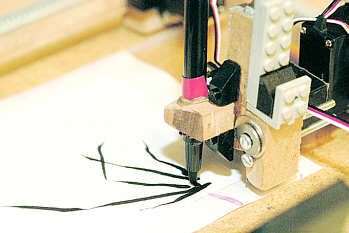
The flower-drawing device was
made by Kiju Lee and Wooram Park.
PHOTO BY HPS/WILL KIRK
|
The trio gave its Critics Choice Award to a robotic
artist called Naan, a Korean word for orchid. The device,
made by mechanical engineering majors Kiju Lee and Wooram
Park, drew an elegant flower design on paper. "We're
engineers, not artists," Lee said. "But the [ArtBot]
concept is pretty cool."
The judges' Risky and Rickety Award went to a robot
called Dust & Shake, built by Steve Garber, a mechanical
engineering major, and Libet Santin, a biomedical
engineering/electrical engineering major.
The Cat's Meow Award was collected by CATBOT, devised
by computer engineering major Oleg Bisker and mechanical
engineering major Eric Nothnagel.
The 3rd Stone from the Sun Award went to SprayBot,
assembled by Carlo Cabanilla, a computer engineering major,
and Jianyi Liu, an electrical engineering major.
Art show visitors also cast ballots for their favorite
robots. The top vote-getter and recipient of the People's
Choice Award was Trace-y, the hand-tracing robot designed
by Reuben Brewer, a mechanical engineering major, and Dan
Ursu, a biomedical engineering/mechanical engineering
major.
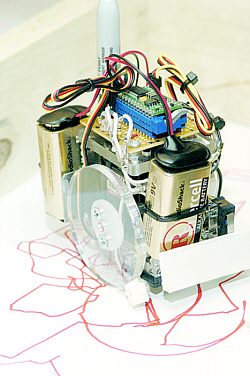
Habitat for Hardware, built by
John Dickinson and Russ Hayden, drew random
patterns.
PHOTO BY HPS/WILL KIRK
|
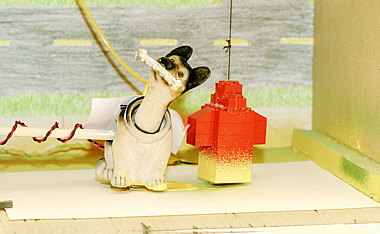
A robotic dog that sprays yellow
paint on a Lego hydrant — called 'performance art' by
its creators, Jimmy Ballew and Phil Nigon — drew
smiles and an honorable mention.
PHOTO BY HPS/WILL KIRK
|
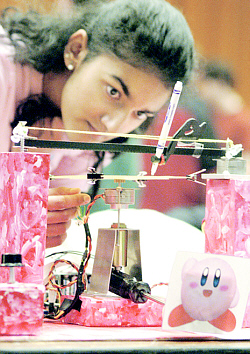
Sunipa Saha adjusts the
electronics on Kurvy Kirby, which she built with Carol
Reiley.
PHOTO BY HPS/WILL KIRK
|
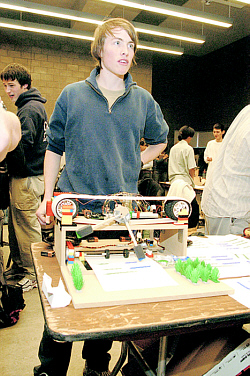
John Henson shows off
brush-wielding SeuratBot, which he built with Kevin
Knott.
PHOTO BY HPS/WILL KIRK
|
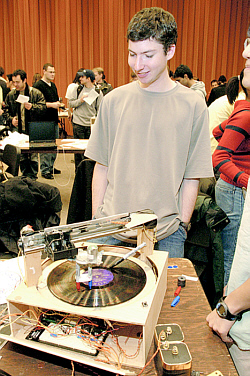
Andy Barnes and Pete Yee combined
modern robotics with an old-fashioned vinyl record to
create 53 70 69 6E, a device that puts a new spin on art
production.
PHOTO BY HPS/WILL KIRK
|
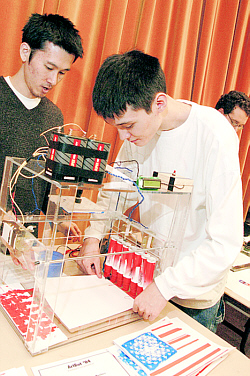
Tomo Yamamoto and Jon Blancha
devised a flag-making BannerBot.
PHOTO BY HPS/WILL KIRK
|